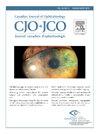Advancing the visibility of outer retinal integrity in neovascular age-related macular degeneration with high-resolution OCT
IF 3.3
4区 医学
Q1 OPHTHALMOLOGY
Canadian journal of ophthalmology. Journal canadien d'ophtalmologie
Pub Date : 2025-02-01
DOI:10.1016/j.jcjo.2024.05.014
引用次数: 0
Abstract
Objective
To compare the visibility and accessibility of the outer retina in neovascular age-related macular degeneration (nAMD) between 2 OCT devices.
Methods
In this prospective, cross-sectional exploratory study, differences in thickness and loss of individual outer retinal layers in eyes with nAMD and in age-matched healthy eyes between a next-level High-Res OCT device and the conventional SPECTRALIS OCT (both Heidelberg Engineering GmbH, Heidelberg, Germany) were analyzed. Eyes with nAMD and at least 250 nL of retinal fluid, quantified by an approved deep-learning algorithm (Fluid Monitor, RetInSight, Vienna, Austria), fulfilled the inclusion criteria. The outer retinal layers were segmented using automated layer segmentation and were corrected manually. Layer loss and thickness were compared between both devices using a linear mixed-effects model and a paired t test.
Results
Nineteen eyes of 17 patients with active nAMD and 17 healthy eyes were included. For nAMD eyes, the thickness of the retinal pigment epithelium (RPE) differed significantly between the devices (25.42 μm [95% CI, 14.24–36.61] and 27.31 μm [95% CI, 16.12–38.50] for high-resolution OCT and conventional OCT, respectively; p = 0.033). Furthermore, a significant difference was found in the mean relative external limiting membrane loss (p = 0.021). However, the thickness of photoreceptors, RPE integrity loss, and photoreceptor integrity loss did not differ significantly between devices in the central 3 mm. In healthy eyes, a significant difference in both RPE and photoreceptor thickness between devices was shown (p < 0.001).
Conclusion
Central RPE thickness was significantly thinner on high-resolution OCT compared with conventional OCT images explained by superior optical separation of the RPE and Bruch's membrane.
Objectif
Comparer la visibilité et l'accessibilité de la rétine externe dans la dégénérescence maculaire liée à l’âge néovasculaire (DMLAn) mesurées par deux appareils de tomographie par cohérence optique (OCT).
Méthodes
Dans le cadre de notre étude exploratoire transversale prospective, les différences quant à l’épaisseur et à la perte des couches rétiniennes externes individuelles dans des yeux atteints de DMLAn et dans des yeux sains appariés pour l’âge ont été mesurées par deux appareils d'OCT (Heidelberg Engineering GmbH, Heidelberg, Allemagne), soit un tomographe en haute résolution dernier cri, et le tomographe SPECTRALIS® classique. Les yeux atteints d'une DMLAn et présentant au moins 250 nL de liquide rétinien, quantifié par un algorithme d'apprentissage profond approuvé (dispositif de surveillance de liquide, RetInSight, Vienne, Autriche), répondaient aux critères d'inclusion. On a procédé à une segmentation automatique des couches rétiniennes externes que l'on a corrigée manuellement. On a comparé l’épaisseur et la perte des couches obtenues avec les deux appareils à l'aide d'un modèle linéaire à effets mixtes et d'un test t apparié.
Résultats
Ont été inclus 19 yeux de 17 patients atteints de DMLAn évolutive et 17 yeux sains. Dans les yeux présentant une DMLAn, les mesures de l’épaisseur de l’épithélium pigmentaire rétinien (EPR) différaient significativement entre les appareils (25,42 μm; intervalle de confiance [IC] à 95 % : 14,24–36,61 et 27,31 μm; IC à 95 % : 16,12–38,50 selon l'OCT en haute résolution et l'OCT classique, respectivement; p = 0,033). On a en outre noté une différence significative en ce qui a trait aux mesures de la perte moyenne relative de la membrane limitante externe (p = 0,021). Cela dit, les mesures de l’épaisseur des photorécepteurs, de la perte d'intégrité de l'EPR et de la perte d'intégrité des photorécepteurs ne différaient pas significativement entre les appareils dans la zone centrale de 3 mm. Dans les yeux sains, une différence significative a été observée entre les appareils quant aux mesures de l’épaisseur de l'EPR et des photorécepteurs (p < 0,001).
Conclusion
L’épaisseur de l'EPR central était significativement moindre selon l'OCT en haute résolution, comparativement à l'OCT classique, phénomène qui s'explique par une meilleure séparation optique de l'EPR et de la membrane de Bruch.
利用高分辨率 OCT 提高新生血管性老年黄斑变性患者视网膜外层完整性的可见度。
目的比较两种 OCT 设备在新生血管性老年黄斑变性(nAMD)患者视网膜外层的可见性和可及性:在这项前瞻性、横断面探索性研究中,我们分析了下一代高分辨率 OCT 设备和传统 SPECTRALIS OCT(均为德国海德堡海德堡工程有限公司生产)在新生血管性老年性黄斑变性患者和年龄匹配的健康眼中视网膜外层厚度和各层损失的差异。经认可的深度学习算法(Fluid Monitor, RetInSight, Vienna, Austria)量化的 nAMD 眼球和至少 250 nL 的视网膜积液符合纳入标准。视网膜外层采用自动视网膜层分割法进行分割,并进行人工校正。使用线性混合效应模型和配对 t 检验比较两种设备的视网膜层损失和厚度:共纳入了 17 名活动性 nAMD 患者和 17 名健康患者的 19 只眼睛。对于 nAMD 眼睛,两种设备的视网膜色素上皮(RPE)厚度差异显著(高分辨率 OCT 和传统 OCT 分别为 25.42 μm [95% CI,14.24-36.61] 和 27.31 μm [95% CI,16.12-38.50];P = 0.033)。此外,平均相对外缘膜损耗也存在明显差异(p = 0.021)。然而,在中央 3 毫米的范围内,不同设备的感光体厚度、RPE 完整性损失和感光体完整性损失没有显著差异。在健康眼睛中,不同设备的 RPE 和光感受器厚度均有显著差异(p < 0.001):结论:与传统 OCT 图像相比,高分辨率 OCT 图像的中央 RPE 厚度明显较薄,这是因为 RPE 和布鲁氏膜的光学分离度较高。
本文章由计算机程序翻译,如有差异,请以英文原文为准。
求助全文
约1分钟内获得全文
求助全文
来源期刊
CiteScore
3.20
自引率
4.80%
发文量
223
审稿时长
38 days
期刊介绍:
Official journal of the Canadian Ophthalmological Society.
The Canadian Journal of Ophthalmology (CJO) is the official journal of the Canadian Ophthalmological Society and is committed to timely publication of original, peer-reviewed ophthalmology and vision science articles.

 求助内容:
求助内容: 应助结果提醒方式:
应助结果提醒方式:


